Which container for a septic tank is better to choose + how to make it yourself
The idea of building a septic tank sooner or later arises in any owner of a summer cottage or country house.Local sewerage, along with water supply and heating, allows you to spend time outside the city without giving up your usual comfort.
Agree, not every summer resident is ready to spend a considerable amount of money to buy a septic tank. Many thrifty owners solve the problem by independently constructing a waste storage tank.
At the stage of designing an autonomous sewer system, you will have to select a container for the septic tank, calculate its volume, and study the requirements for the placement and installation of the tank. All these questions are described in detail in the article.
The content of the article:
Types of septic tanks and their features
A septic tank is the main element of an individual sewer system, which allows residents of a country house to use all the benefits of civilization (warm toilet, shower, dishwasher and washing machine, etc.) without poisoning the environment.
With its help, sewage water is effectively purified and disposed of.
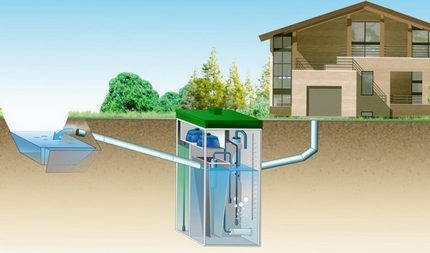
The entire set of these structures is divided into the following types:
- Storage device. This can be called a simple plastic tank dug into the ground. An ordinary pit, the walls and bottom of which are isolated from the ground using bricks, concrete rings or continuous concreting, is also considered a storage tank.In essence, we are talking about a cesspool in which waste products accumulate and are subsequently pumped out and removed.
- Overflow septic tank. This structure usually consists of two or three wells. In them, sewage waste is not only collected, but also purified through the process of settling and gradual separation when moving the waste mass from one chamber to another. Additional cleaning is carried out by anaerobic bacteria.
- VOC (local treatment stations). These are the most modern, very comfortable, although very expensive buildings. In addition to anaerobes and aerobes, the purification process involves multi-stage filtration systems, UV devices, etc. There are many models of such stations, but their operation requires electricity, which complicates their widespread distribution.
The first of these options requires regular pumping of the entire waste mass. In the second, clarified and purified water must pass through a ground purification system before disposal. The remaining fractions are removed using sewage disposal machines for this work.
The third type allows you to discharge treated wastewater into the ground, reservoir, or ditch without performing additional treatment operations.
Regardless of the technical complexity, the degree of cleaning performed and the dependence on energy supply in septic tank installation the same types of containers are used, made of polymer compounds, concrete or brick.
The final choice of container for a septic tank is influenced by:
- expected volume of waste;
- type of soil in the area where the future structure will be installed;
- proximity of groundwater to the earth's surface;
- operating conditions of the facility - seasonality, intensity, etc.;
- complexity of future installation work;
- cost of materials and services.
It is possible that when choosing a container, you will come to the conclusion that it is easier and more convenient to build a septic tank yourself. Great, let’s consider this scenario.
Technology for making homemade septic tanks
Like any other thing, a septic tank can also be made with your own hands. The requirements for this product will remain unchanged. This most important element of local sewerage must be functional, durable and safe to use.
To make a container for a septic tank with your own hands, they use a variety of materials: concrete rings, bricks, Eurocubes, and so on. Even used tanks for various purposes and car tires will do. Let's look at the most popular ways to independently make the containers we need.
Concrete rings are the most popular material
It is believed that it is the containers made of concrete rings easy to install and maintain. Therefore, they are most often used for the construction of septic tanks. An overflow sewer made of such material may, for example, include two or three wells, each of which has its own purpose.
In the first well made of concrete rings, the bottom is also concreted. A drain pipeline is connected to it, through which sewage will move. The slope towards the well when laying drain pipes should be 2 cm per meter.
Inside the well, heavy fractions are separated from light ones. The first ones settle to the bottom, and the second ones go to the next container.
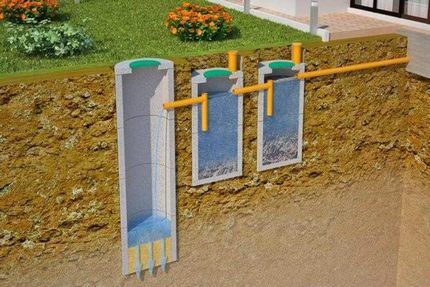
As a rule, the second tank differs from the first only in size: it may be smaller. This is where wastewater is filtered. For this purpose, filter materials are used: expanded clay, gravel and others. The treated wastewater is sent to the third well. From this third container, the liquid should be absorbed into the soil.
This design has a number of advantages:
- Simplicity. The design is really simple. Its construction does not require deep knowledge. You need physical strength and minimal information about the basic rules of sewerage operation.
- Relatively low cost. If we compare the costs of building a septic tank from reinforced concrete rings and concreting the tank with our own hands, the rings will cost less.
- Construction speed. If the deadlines for commissioning a local sewer system are running out, then a concrete structure is what you need. It can be built quite quickly.
In addition, this structure is characterized by increased resistance to mechanical damage and has a significant usable volume.
The building also has disadvantages:
- Design features. A well consisting of massive concrete rings may not be heavy enough to withstand the movement of heaving soil in areas where such a danger exists in principle. It is better to weld the septic tank rings to each other using staples or metal plates.
- Difficulties during the installation process. Much attention should be paid to sealing joints. This is a rather labor-intensive process that requires attention and concentration. If the joints are not properly sealed, untreated wastewater may enter the ground.
- Expenses for special equipment. It is clear that it is necessary to deliver the rings to the site where the septic tank is assembled using special transport. But during the installation process itself, a crane may be needed, which will increase the total cost.
There are two options installation of a septic tank from rings.
Option #1. You can use an excavator to dig a common pit.All the rings are installed into it using a crane, after which overflow pipes are laid and all cracks and joints are sealed.
The wells are sealed and insulated, then covered with soil and compacted.
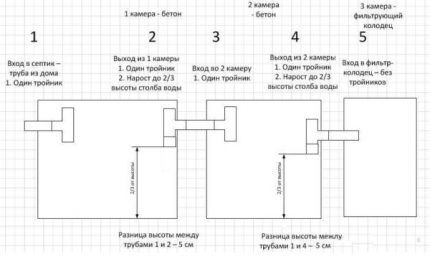
Option No. 2. With it, the lower rings of the wells are first installed on the ground, and the soil is excavated inside them and under the wall. The rings sink into the ground under the influence of their own weight. In this case, initially the wells will not have a bottom. It is poured later in each of the storage wells, which somewhat reduces the reliability of the structure.
Insulating a septic tank with the second method becomes more difficult. To lay overflow pipes, you will also need to dig trenches. This is a more labor-intensive and relatively time-consuming method, but it can be used by those who want to do all the work themselves.
Our task is to figure out how to make a septic tank yourself. And the method of creating a well does not change depending on the installation method. Therefore, we will take a closer look at the first installation method with digging a common pit.
The construction process includes a number of standard steps:
For storage wells, we choose rings with locks: their degree of sealing is higher, they are easier to install and are less likely to move in the event of frost heaving of the soil.
Even before installation, it is recommended to treat them with Penetron-type impregnation or bitumen mastic for the purpose of waterproofing.
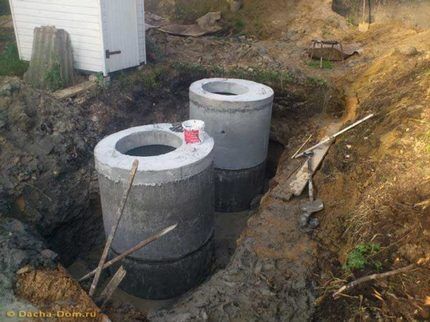
We cover the bottom of the pit with crushed stone 20 cm thick. It should be compacted well, achieving a strictly horizontal surface. The quality of work can be checked with a building level at 2 m.
Rings with a bottom are placed on the crushed stone. We leave a gap of 0.5 m between the storage wells, which will be filled with soil and, in case it moves, will act as a buffer. The walls of the initial rings must be positioned strictly vertically to make the well more stable.
If a decision is made to pour a monolithic concrete slab under the storage wells, then its thickness should be at least 30 cm, and the base should be 20 cm larger on all sides than the area occupied by the wells. The slab must be level and strictly horizontal.
In this case, the first rings can be installed only after the concrete has matured, and this will take 28 days.
The junction of the initial rings with the slab is sealed. For this purpose, a roller of Aquacement is placed under the ring - a concrete mortar with high waterproofing properties.
The remainder of the Aquacement squeezed out from under the base is used for joints of rings. The rings are placed one on top of the other, forming a well. All joints and cracks between them are coated with concrete mortar Aquacement and treated with a waterproofing compound.
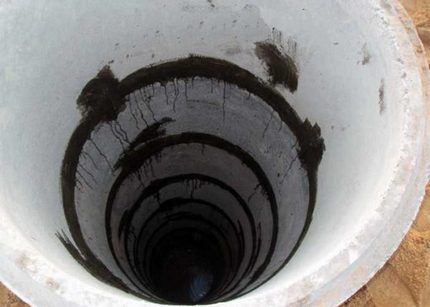
Toxic compounds should not get inside the well, otherwise they will disrupt the decomposition processes of wastewater bio-inclusions.
Connections using metal brackets installed outside serve as additional fixation of the rings to each other. The “entrances” of the brackets are concreted and protected with waterproofing. That part of the septic tank, which is located above the freezing depth, is insulated with expanded polystyrene.
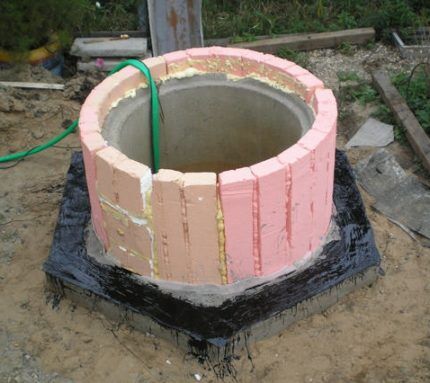
Necks are often installed above the top of wells. They are made in order to save the volume of the empty part of the septic tank, which is above the overflow pipe.
Such necks are constructed from bricks coated with cement and waterproofing, ready-made reinforced concrete products or monolithic reinforced concrete made by hand using formwork.

There are features of installing the third filter well or absorption column. For it, the pit should be deepened down to sandy soils that can drain water. The bottom of the pit is covered with 20-25 cm of crushed stone, and then 30-40 cm with sand. The lower ring of this well should not have a bottom.
If the filtration properties of the rocks exposed by the column are insufficient for the unhindered disposal of purified wastewater, for example, there are layers and lenses of sandy loam in the sand layer, then I install side filters.
In this case, perforated rings are added to the column. The holes in them are at least 30-50 mm in diameter so that they do not become clogged with soil.
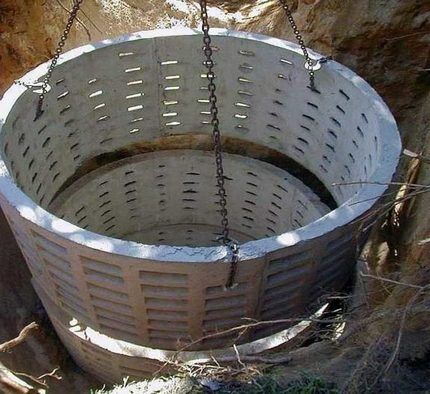
It would also be good to replace the soil surrounding the filtration column with crushed stone. In this case, it will be easier for the treated waste to be absorbed.
Eurocubes are an excellent basis for a septic tank
Plastic is an ideal choice, since this material will not burst even in the event of severe frosts. In addition, septic tanks constructed from plastic containers last a long time, because... does not react to aggressive environments.

Eurocubes are light in weight, which provides additional advantages during installation. No special equipment is needed to install them. External frames allow you to fill Eurocubes with earth: they do not deform.
It will take 72 hours for high-quality wastewater treatment. The required total capacity of the septic tank will depend on the total amount of water used by all residents of the dacha in three days.
Taking into account the fact that one person spends on average 200 liters of water per day, a family of three consumers needs a septic tank consisting of three tanks and holding more than 1800 liters of liquid.
Before starting to dig a pit, you need to measure the tanks, after which the excavation work begins. A sand cushion (30 cm) is poured onto the bottom of the pit, then concrete (20 cm) is poured.
This means that the depth of the pit should exceed the height of the Eurocube by 50 cm and by the top layer of backfill. A Eurocube placed in a pit should be 30 cm away from its walls along the entire perimeter.
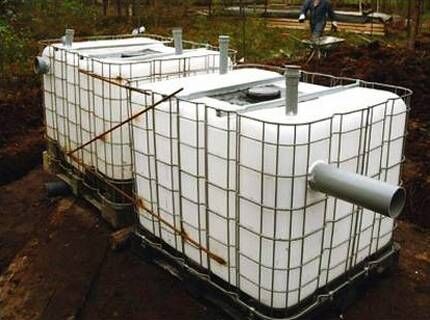
If groundwater in your area is located close to the surface, and there is a threat of a lightweight plastic septic tank floating up, it needs to be weighted by securing it with plastic straps to a concrete base or at least to standard curb stones, placing them on both sides of the structure.
Additional recommendations for choosing a septic tank for high groundwater are given in this article.
The cubes should be arranged in a cascade so that the drains flow from the top to the bottom on their own. A pipe coming from the house enters the first tank and has an outlet into the adjacent tank. It, in turn, is connected to a third cube, the outlet of which goes into the filtration field.
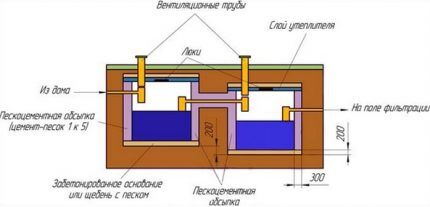
In addition to the Eurocubes, you will need 6 tees and plastic pipes with a diameter of 150 mm for transitions between cubes and creating ventilation holes.
To prepare Eurocubes for installation, you need to cut holes:
- around the neck of the cube so that a tee goes inside the container;
- on the side of the cube 20 cm from its top for the incoming pipe, which is connected inside the compartment to a tee;
- on the opposite side surface 40 cm from the top for an exit pipe going into the adjacent cube;
- on the cover for mounting the ventilation pipe.
The septic tank is assembled sequentially from the first tank to the second, and from it to the third. Each subsequent cube should be 20 cm lower than the previous one. You can get by with just two cubes, which will significantly reduce the cost of work. All connections of the structure are carefully sealed.
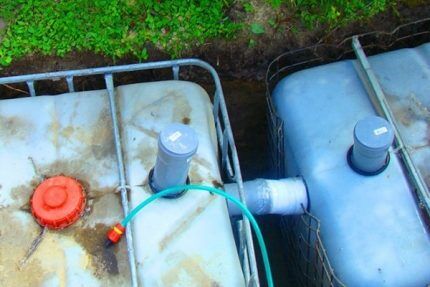
To backfill a pit, you need a mixture of five parts sand to one part cement. The dry components of this mixture are mixed, covered with a layer of 30 cm, and then compacted.
Do the same with subsequent layers. The chambers of the cubes are filled with water so that the filled soil does not deform them. The upper part of the cubes is protected from freezing with sheets of foam plastic or filled with foam insulation.
Brick tank - long but reliable
The owner who took build a septic tank from brick, has decent reserves of time, knows how to handle not only a shovel, but also a trowel, and is ready for painstaking work in the hope of the longevity of the structure.
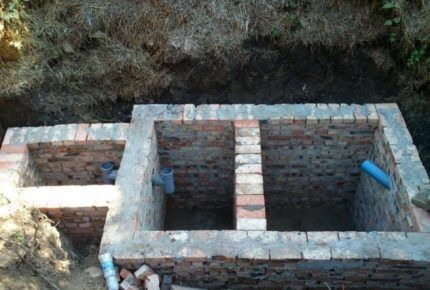
Having completed preliminary calculations and decided on the volume of the future pit, you can begin its construction.
The advantages of this choice include:
- availability of source material;
- the brick product is designed for long-term use;
- bricklaying requires certain skills, but their absence can be compensated for by the home craftsman’s ability to adapt to any job;
- All models of septic tanks can be made from bricks;
- a brick tank can be of any size, which makes it easy to correlate it with the parameters of the site.
The disadvantages include the need for additional insulation of the brick, since initially it does not have special insulating properties. In addition, a lot of time and effort will have to be spent on the construction of this facility.
For the work you will need bricks, of which full clinker 240x115x71 is preferable. The walls will be built with single-row masonry, and the partition will be made of two bricks.
You need to prepare:
- sand;
- cement ShPTs400 (not lower);
- waterproofing material such as bitumen mastic;
- fittings 10 mm thick made of stainless steel;
- for each of the chambers a cover with a hatch;
- tools for excavation and construction work.
The finished pit should be 10-15 cm larger than the corresponding dimensions of the future structure. Installing temporary formwork will prevent the soil from crumbling.20-30 cm of crushed stone is poured onto the flat bottom of the pit, and then 40-50 cm of sand.
The resulting pillow is moistened with water and compacted tightly. A reinforcing mesh is laid on top of it, which is filled with concrete (30 cm) and left to harden for 10 days.
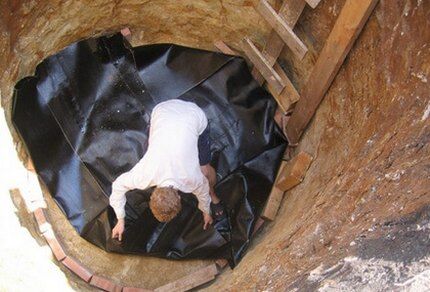
The walls are laid out according to the diagram, leaving gaps for the pipes. It is recommended to add liquid glass to the cement solution to increase strength. Waterproofing is carried out using bitumen mastic, applying a layer of 3 mm. The finished tank is equipped with ventilation, a top plate is installed, on which there is a hole for a hatch.
The brick structure is filled with clay, having previously connected the septic tank to the sewer system. The operation of the finished structure is checked by filling it with clean water. A clay castle 1 meter wide and half a meter deep can be used as external insulation of the structure.
Old tires are also an option
The most inexpensive material from which containers for a country septic tank are made are old car tires. The advantages of this option are obvious - affordability and simple installation.
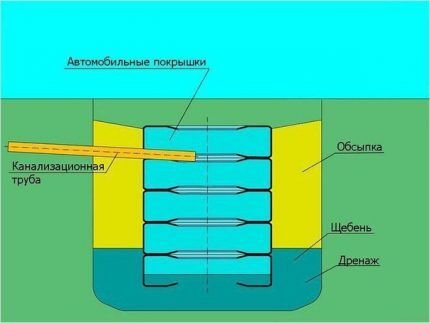
However, the disadvantages of the method are also obvious:
- with the help of such a septic tank, only a small amount of wastewater can be processed;
- The tire septic tank is cumulative, that is, it involves periodic pumping of the accumulated contents;
- It is problematic to seal the joints and the tires themselves, so there is a high risk of soil contamination with sewage.
Volume tire septic tank depends on the rate of water consumption by one resident of the house and the total number of residents. As a rule, 5-7 tires per well are enough. However, tires are also different.
Installation of the treatment plant is simple. Before digging a pit for a septic tank from two wells, you need to mark the area. The dimensions of the wells are marked using tires, laid out on the ground.
The tire for the second tank is placed not far from the first. It can be larger: it is better to make the second well larger than the first. After marking, we dig one hole for both containers.
The bottom of the well must be protected from the penetration of wastewater into the ground. To do this, it is either concreted or a plug made of clay 20-25 cm thick is made on it. The well itself is made of tires, the upper part of which is removed using a jigsaw.
The strength of the connection between the tires is ensured by their pairwise bond: the upper tire is tied with wire to the lower one. All seams, punctures and joints are reliably sealed.
The transition pipe is inserted into a hole that is cut at a height of 2/3 from the bottom of the pit. For the incoming pipe in the upper part of the first well, you also need to cut a similar hole.
Plastic pipes are used to transport wastewater. The pit should be filled with sand and the soil that was removed during the digging process. For each of the wells you need a cover made of a material that does not rot - you can choose polymer manhole.
Conclusions and useful video on the topic
A visual representation of any process is better perceived than a printed word. That's why we put all these videos together.
See how you can independently build a septic tank consisting of three wells, using factory-made concrete rings for containers:
Happy owners of Eurocubes have almost ideal material for the construction of individual sewage systems. It is just important not to forget that the relatively low weight of the cubes themselves can be a problem when the soil swells.
How to use Eurocubes, watch the video:
Bricks are often used in the construction of various objects. They can also be a good material for a septic tank. The video will show you the nuances of such a structure:
Choosing material for a country septic tank is not an easy task. You need to not only estimate your financial capabilities, but also find out the features of the area where this structure will be operated. Having collected all the necessary information and armed with information, you will make a choice that you will not regret later.
Do you have experience in solving similar problems? Or still have questions on the topic? Please share your opinion and tell us what kind of septic tank you use. You can leave comments in the block below.




Once again I am convinced that not everything can be done with your own hands. Well, why invent a bicycle? It’s better to order a container for a septic tank, it won’t cost that much, than to try to fix a leak or some other problem later. For me, this is already a passed stage. We have a storage unit at our dacha for 3 rings, which is quite enough. It's convenient, we go there every weekend.
This process will be individual for everyone. It is important to note that plastic containers are cheaper and lighter than concrete rings.This makes it possible to transport them without additional physical force, and, accordingly, without additional costs. Personally, I bought a plastic container and installed it myself at the dacha without any effort. Already 2 years in operation. I advise those who want to buy such containers to first figure out which types are best for them.